A message from EatThePlanet.org: "We are happy you found us! We strive to be informative and accurate. Enjoy what you find here! Take a look at our new downloadable pdf eBook A Complete Guide To Foraging. We put a lot of work into this eBook and are very excited to share it with you." - Joe Forager(Owner)
What and Where is it
California Groundcone (Boschniakia strobilacea) is a wild plant native to the west coast, found in Californa and Oregon. Other variations, including the Vancover Groundcone (Boschniakia hookeri), can be found as north as nearly the tip of Alaska. The Northern Groundcone (Boschniakia rossica) primarily is found throughout northern Canada and into Alaska.
The focus of this article will be on the more common, California Groundcone. This strange wildflower, a distant cousin of the mint family, spends nine months of the year underground. It is also parasitic, meaning it draws nutrients from the host. It’s often overlooked because it simply looks like a pinecone just stuck into the ground.
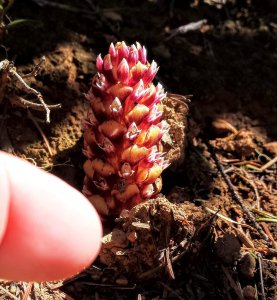
The part of the groundcone that is visible above the ground is called the inflorescence. It is perennial and can be 2 to 7 inches long and is cone-shaped, with multiple stems per plant. These often get confused with Douglas Fir Pinecones, being such a similar size and shape. But, these are actually a wildflower. Purple/red flowers stick out from the stem. The flowers are round and have fruit-bearing seeds that are very small, about 2mm. You can see these flowers blooming between May and July. The dried remains of the inflorescences will stay behind on the forest floor long after the flowers have wilted, giving them the look of a dried-out fir cone.
Parasitic
California Groundcone doesn’t perform photosynthesis like most green plants we see around us in the world. Instead of using sunlight for food, “it uses haustoria – specialized roots – to attach to and take nutrients from the roots of Pacific madrone trees (Arbutus menziesii) and manzanita shrubs (Arctostaphylos spp.). Although it is a holoparasite, meaning that it is fully dependent on its host for survival, there is currently no scientific evidence that it is harmful to its hosts.” Being that this requires the roots of Madrones and Manzanitas to grow, you can even surprisingly find them where hosts aren’t present because of how long the root systems of the host plants can grow. Mostly, you’ll find them on the edges of trails in mixed conifer woodlands.
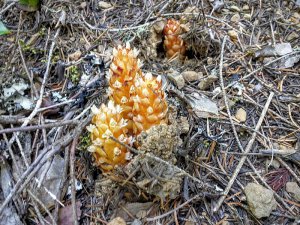
Health benefits
The US Forest and Wildlife Service at the Kenai National park shares in their Refuse Notebook from 2017 that, “The Northern Groundcone has a long history of being a medicine among northern cultures. In some First Nations and Native American tribes the whole plant is dried, ground, and used as a topical application, and sometimes smoked in a pipe. The Dena’ina called it qinaz’in, or ‘hat which sticks up’. It is widely used in Chinese traditional medicine as a substitute for Cistanches Herba, a famous stamina tonic agent, and it reportedly prevents senility. Other traditional applications include cleansing and nourishing the kidneys in tonic form, curing impotence in men, strengthening the heart, easing constipation, alleviating skin rashes, increasing memory retention, and treating coughs. As it turns out, groundcones also contain chemical compounds that are attractive to cats and can induce the ‘catnip response’.”
Edible uses
Should you find yourself along a west coast trail, happen upon some groundcone, and want to eat them you have a few options. First, you can peel and boil the tuber, similar to a potato. This plant can be, and often is, eaten raw for quick trail food by hikers and Native Americans alike. You can also dry the tuber and crush it into a topical poultice for coughs, per the Native American tradition. However you choose to use this medicine, please honor the forest and never forage all you see. Always leave some behind for the next person and for the forest to continue to use.
—————
Written by Shauna Wildey
She is a mother of three turned writer living along the Third Coast in Grand Rapids, Michigan. She is a trained herbalist at the Naturopathic Institute of Therapies and Education in Mt Pleasant, Michigan. She is a certified reiki master and yoga instructor, a metalsmith, and carries a BA in History. Inquiries can be sent to shaunamarie87@gmail.com
Many of our readers find that subscribing to Eat The Planet is the best way to make sure they don't miss any of our valuable information about wild edibles.
See our privacy policy for more information about ads on this site

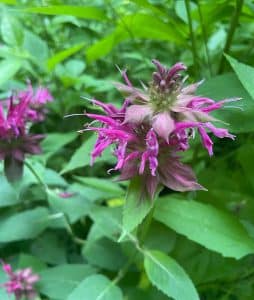
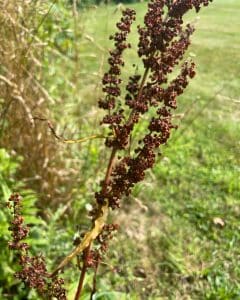



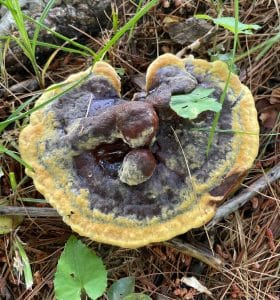
One Response
Please – encouraging people to eat ground cones is not good – they are not common!!! Humans take far more than enough already from this land.